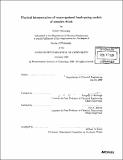| dc.contributor.advisor | Paul I. Barton. | en_US |
| dc.contributor.author | Titievsky, Kirill | en_US |
| dc.contributor.other | Massachusetts Institute of Technology. Dept. of Chemical Engineering. | en_US |
| dc.date.accessioned | 2009-08-26T17:00:29Z | |
| dc.date.available | 2009-08-26T17:00:29Z | |
| dc.date.copyright | 2009 | en_US |
| dc.date.issued | 2009 | en_US |
| dc.identifier.uri | http://hdl.handle.net/1721.1/46597 | |
| dc.description | Thesis (Ph. D.)--Massachusetts Institute of Technology, Dept. of Chemical Engineering, 2009. | en_US |
| dc.description | Includes bibliographical references (leaves 143-148). | en_US |
| dc.description.abstract | Bulk properties and morphology of block copolymers and polymer blends are highly sensitive to processing history due to small free energy differences among various stable and metastable states. Consequently, modeling these materials requires accounting for both thermal fluctuations and non-equilibrium processes. This has proven to be challenging with traditional approaches of energy minimization and perturbation in field theories. At the same time, simulations of highly coarse-grained particle-based models, such as lattice chain Monte Carlo and bead-spring simulations, have emerged as a promising alternative. The application of these methods, however, has been hampered by a lack of clear physical interpretation of model parameters.This dissertation gives a rigorous interpretation to such coarse-grained models. First, a general thermodynamic approach to analyzing and comparing coarse-grained particle models is developed. Second, based on the analysis, a specific particle-based model is constructed so that it is unambiguously related to the standard Gaussian chain model and related field theories at realistic molecular weights. This model is complementary to field theoretic polymer simulations, which are computationally prohibitive for realistic molecular weights. Several applications of the model are demonstrated, including: fluctuation corrections to mean-field theories of block copolymers as well as a detailed investigation of the key effects governing the self-assembly of diblock copolymers confined in cylinders such as fibers or pores. The latter application introduces a novel impenetrable wall boundary model designed to attenuate effects of the walls on the total monomer density. The general approach and the specific models proposed here will find immediate application in modeling effects of flow, metastability, and thermal fluctuations on the morphology of complex fluids with molecular weights of 104 - 106 g/mol using lattice and continuous space molecular simulations. | en_US |
| dc.description.statementofresponsibility | by Kirill Titievsky. | en_US |
| dc.format.extent | 148 leaves | en_US |
| dc.language.iso | eng | en_US |
| dc.publisher | Massachusetts Institute of Technology | en_US |
| dc.rights | M.I.T. theses are protected by
copyright. They may be viewed from this source for any purpose, but
reproduction or distribution in any format is prohibited without written
permission. See provided URL for inquiries about permission. | en_US |
| dc.rights.uri | http://dspace.mit.edu/handle/1721.1/7582 | en_US |
| dc.subject | Chemical Engineering. | en_US |
| dc.title | Physical interpretation of coarse-grained bead-spring models of complex fluids | en_US |
| dc.type | Thesis | en_US |
| dc.description.degree | Ph.D. | en_US |
| dc.contributor.department | Massachusetts Institute of Technology. Department of Chemical Engineering | |
| dc.identifier.oclc | 424642173 | en_US |
